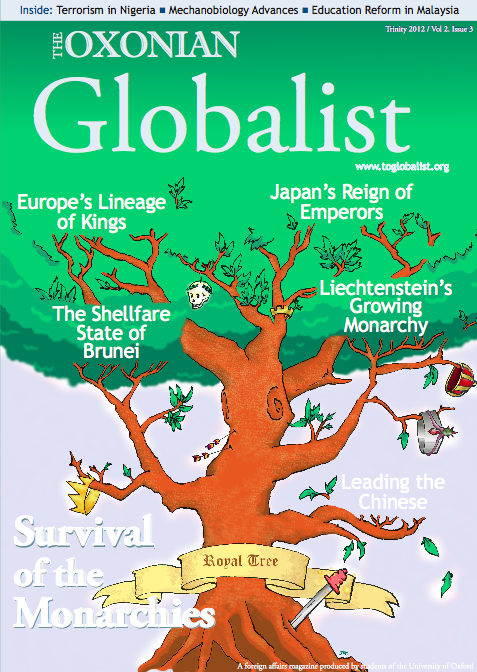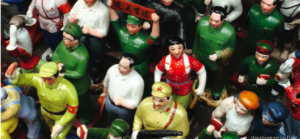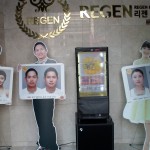Flashlights on the corner of a Shanghai street. A few figures clustered around a tatty blanket covered in curios and jumbled “antiques”. People drifting in to examine the objects while the flashlights send shadows spinning out onto the empty road.
It is 4am on a Saturday morning. We are near the Yew Gardens, a market area redeveloped to mimic what China should look like to Westerners (think upturning eaves and dragon statues). Except, the tourist bazaar is closed at night and a separate market is taking shape on the dark streets outside.
We’re waiting for a flight. Or rather, waiting for the subway to open so we can go to the airport and wait for a flight. The night has been long, and dull, but stumbling across this fair reminds us that in China nothing is to be taken for granted and every turn can throw up something completely unexpected.
At this time there are no crowds of internationals milling about, no mass-produced parasols on offer, and no rickshaws clattering past looking for custom. Just the blanket, its curios, and the growing crowds.
In just 15 minutes, the entire street is lined with similar groups. Local dealers arrive on scooters or push-bikes laden with suitcases full of whatever they think will sell. There is a continuous rustle of newspaper as the sellers unload their wares and line the narrow street with their blankets. An incredible array of objects is assembled and a bustling antiques trade begins.
So, at 4am the narrow street funnels antiques enthusiasts, most armed with notebooks or shopping lists, down a gauntlet of blankets. Inkpots and vases change hands to the tune of cheerful haggling, while the torch beams reel from chopstick holders to statuettes of Mao.
Tea sets abound. But it is not just the usual junk available here. The interested buyer could pick up anything from moth-eaten calligraphy to a rusted iron radio, enthusiastically touted by its owner as “Communist made! Communist made!”
Not only is there a fascinating range of objects, but also a vast range in quality. Many pieces are in bad condition, such as the dilapidated alarm clocks which can be seen at most blankets – but rarely heard. It is certainly not antiques dealing with the reverence shown to such curios in Europe, but a chaotic Chinese take on a new found market.
Mao figurines in ceramic and bronze, along with stacks of that famous Little Red Book, testify to a legacy of political fervour. In the midst of such an atmosphere, semi-legal at best given China’s strict legislation regarding antique sales, we are confronted with two sides of China. One is the recent communist past, and the other is the country’s current free market explosion.
This night market is evidence of small trade on a large scale, taking place at whatever time is convenient for buyers and sellers to meet without disrupting Shanghai’s more lucrative tourist industry. It is an economy in which the Maoist heritage is just another commodity.
The whole scene (the whole surreal scene given that this is when most of the city is, for once, asleep) makes for an interesting comparison with a Chinese antiques store I browsed in Charlottesville, Virginia. In that store, the furniture was lovingly restored and the silk paintings carefully hung to appeal to Western eyes.
There was a real sense of pride in the Virginian shop. A sense of presenting a quintessence of Chinese art to an American audience and wanting them to be impressed. Very different here in Shanghai. One blanket is flanked by a fractured shell of a wardrobe, the doors and decorative panels torn off and lying on the pavement to be sold separately.
In Charlottesville, they would have been restored and sold as something to treasure. As something more than a commodity, and as a flavour of China.
Perhaps it is a characteristic of most emigrant communities to want to present the very best face of their cultural heritage to their new home. The heightened awareness of what defines your culture that comes from being immersed in another can be an incentive to preserve the past more reverently.
Many residents of Chinatowns around the world even see themselves as the standard-bearers for Chinese culture, believing that back home the traditional values are disintegrating under modernity and government influence.
One symptom of decline that these emigrant communities cite is the proliferation of Western fashion in China. Not only is this changing the Chinese citizen’s appearance, but also the city itself. Shanghai plans to build a series of satellite towns, each modelled on a foreign nation. Britain’s is “Thames Town.”
An article in the Washington Post in 2007 entitled “West Rises in China’s Backyard” describes this cultural cocktail: “The ding-dong from the neo-Gothic church next door signals to Wu Yuqing that it’s time to wake up. On her way to the grocery store each day, she walks past the Cob Gate Fish & Chips shop and bronze statues of Winston Churchill, Florence Nightingale and William Shakespeare.” Finding something to relate to in her surroundings must be difficult for Wu Yuqing.
Disintegration would, of course, be too strong a term – no culture is so monolithic that it does not experience flux – but China is changing particularly quickly and in many different directions. In Shanghai, at the same time old propaganda posters are sold to tourists, wealthy Shanghainese settle down in their own little Kensington.
On an abstract level, public intellectuals in the People’s Republic of China have been very concerned over the last few decades as to how China’s present relates to its past. A brand of “New Confucianism” has gained momentum as a way of reconnecting modern China to its rich heritage, something that would have been unthinkable during the Cultural Revolution of the 1960s and 1970s.
One of the most vocal in this new school, Tu Wei-ming from Harvard University, has even been invited to speak at Peking University, a sign of the People’s Republic of China’s gradual relaxation of cultural restrictions – though Ai Wei Wei would suggest there is still some way to go.
The title of Tu Wei-ming’s paper, “Cultural China: The Periphery as the Center”, neatly summarises the sense of cultural dispersal felt by many Chinese citizens and Chinese emigrants.
Yu Dan, a professor at Beijing Normal University, has called for China’s intellectual legacy to be incorporated into the present. She suggests that Confucius’s Analects offer directions on how to live a good life in the modern world. As a self-proclaimed hedonist, her argument has a certain appeal for a generation searching both for the latest fashion accessory and a link to their past.










